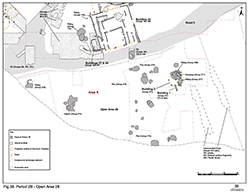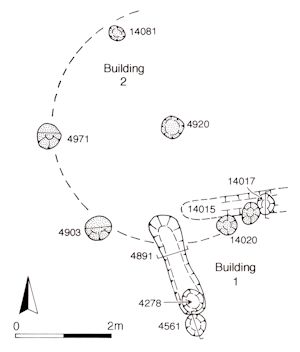
Bounded by Roads 2 and 3 to the north and by ditch 25075 to the east, only the northern end of Open Area 28 is exposed within the area of investigation (Figure 38). Where investigated within Excavation Area K, this most westerly of the southern zone enclosures is seemingly occupied by domestic activity. Stratigraphic relationships and, to some extent, ceramic dating from pits, define chronological development and progression within Period 2B. The identifiably earlier activity is described below; the later is described elsewhere. These probably do not constitute distinct phasing within Period 2B, but rather ongoing change over time.


Post-built circular Building 2 occupies a position in the north-east of OA28, close to Road 3. Post-holes (4903, 4946, 4971, 4996, 14020, 14081 Group 270), which are all sealed by dumping (Group 271), are construed to constitute a roundhouse of c. 5.6m diameter around central post-hole 4920 (Figure 39). Additional post-holes with no relationship to the dumping could also belong to Building 2 but have not been included here. A small quantity of grog-tempered Late Iron Age pottery is present in a single post-hole. Some of its structural elements cut Period 2B pits and its location close to the road may be a further indication of its transitional date - as seen across the southern zone enclosures there appears to be a shift from centrally to northerly located dwellings from Periods 2A to 2B.
Pits 4931, 4933, 14007, 14031, 14039 (Group 269) are sealed either by Building 2 or by the dumping over it. Although most of the pottery can be dated no more closely than Late Iron Age, there is mid-1st century AD samian present in pit 14031. Pit 14007 contains a metalworking mould fragment and copper-alloy cast waste (SF4194).
The remainder of the investigated OA28 pits (4018, 4031, 4155, 4203, 4376, 4499, 4522, 4776 Group 275) are filled during the Late Iron Age, no later than the mid-1st century AD. Of these, 4018 and 4155 are the only large examples excavated, both in excess of 2m in diameter. The others are 1.40m diameter or less; this may explain their relative lack of finds. Their artefact assemblages are dominated by pottery, together with quantities of burnt daub, briquetage and loomweight fragments. Animal bone is generally scarce, most probably a result of unfavourable conditions of preservation. Items such as loomweights, spindlewhorls, and quern fragments all indicate a domestic origin for the materials filling these pits. Copper-alloy cast waste (SF8346) is present in pit 4776 and may indicate metalworking activity close by.
Hearth 14104 (Group 274) is a shallow scoop excavated within a poorly understood, and generally unphased sondage, toward the western side of OA28, which contains a collection of flint cobbles and gravel. It is clearly a seat of burning, with the cobbles being cracked and reddened. There are no associated artefacts and this feature is consequently undated. Although this feature offers the only excavated potential source for the infrequent metalworking debris found in pits 14007 and 4776, and subsequently in pit 4786, it remains possible that the undated hearth is in fact earlier and related to the metalworking debris located in preceding Period 2A OA4 (pit 4517 Group 62). However, the use of the hearth for metalworking is entirely speculative.
Internet Archaeology is an open access journal based in the Department of Archaeology, University of York. Except where otherwise noted, content from this work may be used under the terms of the Creative Commons Attribution 3.0 (CC BY) Unported licence, which permits unrestricted use, distribution, and reproduction in any medium, provided that attribution to the author(s), the title of the work, the Internet Archaeology journal and the relevant URL/DOI are given.
Terms and Conditions | Legal Statements | Privacy Policy | Cookies Policy | Citing Internet Archaeology
Internet Archaeology content is preserved for the long term with the Archaeology Data Service. Help sustain and support open access publication by donating to our Open Access Archaeology Fund.